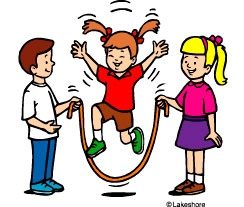
During my placement, I was given a teacher’s handbook on the introduction and use of skipping to improve and inform pupils of how to keep their heart healthy. It was put together by the British Heart Foundation and discusses the benefits to the heart as well as additional pros such as boosting self esteem (British Heart Foundation, 1999).
All of the citations in this blog post are from the British Heart Foundation’s Teacher Handbook (1999).

The Jump Rope for Heart initiative is all about getting children exercising and keeping healthy whilst having fun.through skipping. It is a whole body activity that uses the large muscle groups in the legs, helping to improve overall co-ordination and body streng
th. As it is a weight-bearing activity, it helps with bone density and the management of weight along with a balanced diet. This is important as there is a rise in childhood obesity. Additionally, skipping has the potential to enhance self esteem and self image as well as improve timing and rhythm (pp.5).

Jump Rope for Heart fits well into the curriculum of both NI and Scotland with teaching requirements including encourage pupils to be physically active and engagement in physical activities that develop cardiovascular health, flexibility and muscular strength and endurance (pp.7.
Skipping is nto limited to physical education lessons. It could be incorporated into creative writing, music or mathematical experiments. It allows for exploration of the effects on exercise on the body for older pupils (pp.11).
 Teachers should start right at the basics i.e. without the rope. This sounds a bit strange for a skipping programme but it is important pupils know how to land correctly and safely when they jump. Next is keeping to a rhythm, perhaps by putting some music on as pupils skip. Some pupils may benefit from group or partner skipping in order to further develop their skills and increase their confidence. Once pupils are ready they could move onto more complex techniques such as spinning around or side swings with the rope. Skipping rhymes could be introduced for children to jump along too. This will help challenge children to keep in time to a song (pp. 84-100).
Teachers should start right at the basics i.e. without the rope. This sounds a bit strange for a skipping programme but it is important pupils know how to land correctly and safely when they jump. Next is keeping to a rhythm, perhaps by putting some music on as pupils skip. Some pupils may benefit from group or partner skipping in order to further develop their skills and increase their confidence. Once pupils are ready they could move onto more complex techniques such as spinning around or side swings with the rope. Skipping rhymes could be introduced for children to jump along too. This will help challenge children to keep in time to a song (pp. 84-100).
I would definitely consider using this programme with future classes as there are so many benefits to it. Children can work at whatever level they feel most comfortable at allowing for differentiation. Everyone is able to join in, no matter their age, gender or ability. I think this could be a really enjoyable project for pupils. It does not have to be limited to PE classes and can be adapted to suit the interests and needs of the class e.g. if they have a great interest in maths, they could do experiments involving the length of rope and the time taken to jump 15 times.
References:
British Heart Foundation (1999) Jump Rope for Heart: Teacher’s Manual.

